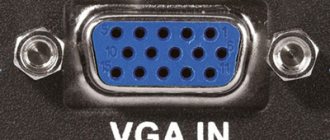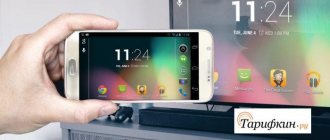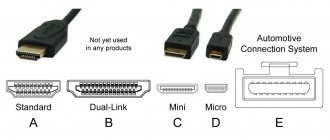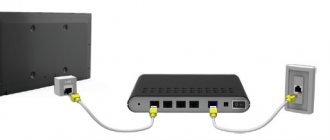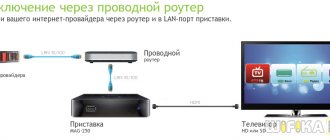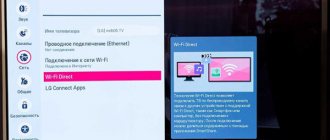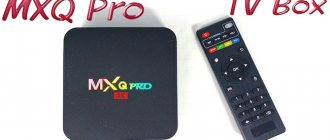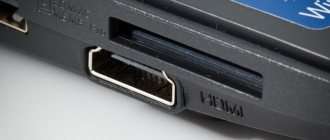The main and most significant feature of connecting a computer and a TV using an RCA cable is that the necessary connectors are not available on video cards by default. Despite this limitation, in further instructions we will talk about methods for such connection.
Connecting a PC to TV via an RCA cable
The process of connecting a PC to a TV using this method is the least recommended, since the final image quality will be quite low. However, if there are no other interfaces on the TV, you can get by with RCA connectors.
Step 1: Preparation
The only current way to convert a video signal from a computer is to use a special converter. The best option is an HDMI to RCA adapter, since the vast majority of video cards are equipped with this interface.
Devices similar to the above can act as a converter for other types of signals, for example, “VGA - RCA”. And although their cost will be somewhat lower, the signal quality and capabilities are inferior to HDMI.
Based on the selected connection interface, purchase a cable to connect the computer and the converter itself. It can be dual VGA or HDMI.
On TVs with the ability to connect devices via an RCA cable, there are three connectors, each of which is responsible for transmitting one signal. Prepare a wire that has plugs with the same colors:
- Red – right audio channel;
- White – left audio channel;
- Yellow – main video channel.
In some cases, you can get by with only one video channel, since audio transmission is supported exclusively by HDMI.
Note: The necessary cables may be supplied with the converter.
If you use a video signal converter, sound from your computer to your TV can be transferred using a “2 RCA – 3.5 mm jack” cable. You can also use a suitable adapter.
Regardless of the type of converter you choose, you need to take into account that such a device requires separate power. In this case, the HDMI - RCA converter receives the required amount of electricity from the PC directly through the cable.
Be careful, a cable for direct signal transmission, for example, “HDMI - RCA” or “VGA - RCA” is not suitable for the task.
Step 2: Connection
We will look at the connection process using the example of two different converters designed to convert HDMI and VGA signals to RCA. The converters mentioned below are perfect for connecting not only a PC and TV, but also some other devices.
HDMI - RCA
This connection method requires the presence of a special converter that converts the HDMI signal to RCA.
- Connect the purchased HDMI cable to the appropriate connector on the video card.
Connect the second plug to the “Input” input on the converter.
Connect the triple RCA cable to your TV, paying attention to the colors. The necessary connectors are usually located in the “AV” block or separated by the designations “Audio IN” and “Video IN”.
Connect the plugs on the reverse side of the cable to the converter. Moreover, if sound transmission is not needed, the white and red wires do not need to be connected.
Use the switch on the converter to select the appropriate image color standard.
If the signal is not automatically transmitted, the converter may not be receiving enough power from the computer's HDMI output. You can solve the problem using the cable included, connecting it to one of the USB ports or using a suitable power adapter.
After these steps, the image from the computer should be displayed on the TV screen.
VGA - RCA
Remember to look at the labels on each connector when using the converter. Otherwise, the video signal will not be transmitted due to incorrect connection.
- Connect the purchased yellow cable to the “Video” or “AV” connector on the TV.
Connect the plug on the reverse side of the wire to the “CVBS” port on the converter.
Note: You can use not only an RCA cable for connection, but also S-Video.
Connect one of the VGA cable plugs to the computer's video card.
Do the same with the cable output, connecting it to the “VGA IN” interface on the converter.
Using the “5V Power” input on the converter and the supplied power adapter, connect the device to a high-voltage network. If the power supply is not included, you will have to purchase one.
The converter also has a menu that can be opened on the TV. It is through it that the quality of the transmitted video signal is adjusted.
After transmitting the video signal, you need to do the same with the audio stream.
2 RCA - 3.5 mm jack
- Connect the cable with two RCA plugs to the “Audio” connectors on the computer.
Connect the “3.5 mm jack” plug to the audio output of the computer. This connector should be marked bright green.
If you have an adapter, you will also need to connect the “3.5 mm jack” and the RCA cable.
Now you can move on to detailed settings of the TV as a monitor.
Step 3: Setup
You can influence the operation of the connected TV through various parameters both on the computer itself and on the converter. However, it is impossible to improve the final quality.
TV
- Use the “Source” or “Input” button on the TV remote control.
From the menu presented on the screen, select the option “AV”, “AV 2” or “Component”.
Some TVs allow you to switch to the desired mode using the “AV” button on the remote control itself.
Converter
- If you are using a VGA to RCA converter, press the Menu button on the device.
Through the window that opens on the TV, set the most suitable parameters for operation.
- The resolution settings deserve more attention.
- This method of transmitting a video signal is much inferior to other connection interfaces. This usually manifests itself as noise on the TV screen.
Computer
- On your keyboard, press the key combination “Win+P” and select the appropriate operating mode. By default, the TV will broadcast the computer desktop.
In the “Screen Resolution” section you can set individual resolution parameters for the TV.
Do not use a value that greatly exceeds the capabilities of the TV.
Once properly connected and configured, the TV will be an excellent addition to your main monitor.
Wireless connection
In the vast majority of cases, the computer is connected to the TV wired, because... There is already a wire available that is used to connect the main monitor.
But sometimes a wireless connection may be more convenient (for example, if you need output to the main monitor, but there is a router for the TV; or you can only connect your computer to the TV via wire without HDMI, i.e. there will be no HD quality).
It is recommended to connect the TV to the computer in one of two ways:
- Bluetooth.
Bluetooth connection example This connection option will be convenient for owners of older digital TVs that were released in the 00s. For your computer you will need to purchase a Bluetooth router. - Wi-Fi. This will already be a network interaction, so one of the devices must act as an access point, and control is performed from the other. If you want to have access to both devices when viewing files on the TV, you need to connect an additional Wi-Fi router and use it as an access point.
After connection, access to the computer memory can be obtained through the connected device manager
There are also less common wireless connection methods that your computer can support.
To use them, it is recommended to purchase a universal media player dongle, Anycast, or an equivalent.
Advice! If there is no device for wireless connection, it is recommended to purchase only a Wi-Fi router.
Bluetooth technology is already somewhat outdated and is found only in modern smartphones and other compact devices, and a universal dongle media player will cost the same amount. In addition, the router can also be used for an Internet connection.
Connecting a laptop to a TV via VGA
This interface, familiar to all PC users, transmits only analog video and is not intended for audio. This type of connector belongs to the D-Sub family, which for many years was the most popular in computer technology and is still widely used today.
To connect a laptop to a TV via a VGA cable, you must:
- Connect the VGA connectors of both devices.
In the TV settings, set the required signal source. To do this, press the button on the remote control marked with the words SOURCE, INPUT or a rectangle with an arrow and select VGA from the proposed list.
Select TV as the main display. To do this, hold down the Fn function key on the laptop and press the button depicting two screens from the F1-F12 range. Depending on the laptop model, its location may vary. In our case, this is the F8 key:
Sound output
With this type of connection, the sound is reproduced through the laptop speakers or external speakers connected to it. You can also transfer sound from the laptop's audio output to the TV using a separate cable.
Smart TV
The development of digital electronics is moving toward the point where all gadgets are becoming multifunctional and capable of replacing other devices. The most striking example of such a transformation is smartphones, which from ordinary “dialers” have turned into portable laptop computers, not much inferior in functionality to full-fledged devices (the same PCs, cameras, voice recorders, etc.).
Smart TV from Samsung is one of the best today
- The development of television technology followed a similar path. A modern TV is not only a means for watching TV programs, but also partly a computer that can be connected to the Internet.
- What does connecting to a computer have to do with it, you ask? It's simple - a PC configured in a certain way can distribute the Internet even via Wi-Fi.
- As for the TV itself with the Smart function, it is not a full-fledged analogue of a computer. Basically we are talking about the use of certain resources - branded and publicly available, for example, YouTube.
- Yes, some models have a built-in browser, but it is almost impossible to use it, due to the fact that the devices do not know how to clear the cache.
Wi-Fi signal receiver for TV
- You can connect the TV in this way using a LAN wire or wirelessly. Not all models have a built-in signal receiver, so you may need to buy an adapter like the one in the photo above. The price for such a device is quite high.
Connecting a laptop to a TV via DVI
DVI provides transmission of a digital, i.e., higher quality video signal, but like VGA it does not support sound. If there is no DVI port on your laptop, you can use a VGA-DVI adapter.
Depending on the available screen resolution, frequency and number of channels, DVI connectors are divided into several types, but these two are the most relevant:
Comparative characteristics of various types of DVI and the appearance of the connectors are given in the table:
You can connect your laptop to your TV via DVI according to the instructions described for VGA. Only DVI must be selected as a signal source in the TV settings.
Sound output
Like VGA, DVI does not support audio transmission. To output sound to a TV, you should purchase a MiniJack cable with standard 3.5 mm plugs, which are connected to the corresponding connectors of the laptop and TV. There is also a DVI cable combined with a minijack.
What is better to use
Depending on the situation and display requirements, you can connect your TV to your computer in different ways.
For normal viewing
If you want to watch a regular movie on a big screen, just use a regular VGA cable. Leave one end connected to the computer's video adapter, and connect the other to the output device.
If it does not have the same port as the monitor, you will need an adapter, which can be purchased at any TV equipment store.
Presentation
Often a large screen is used to show an audience a presentation or other media file. Here the situation is complicated by the fact that the user is usually located opposite the audience. It needs a main monitor to control the display, and the video adapter only has one output port.
In this situation, you can use one of three options:
- Connect using an RCA/SCART cable. This method will be the most universal, because... Suitable for any models, incl. without support for the Smat-TV option.
- Use a VGA/DVI splitter. This is a regular double, connected to a video card, and the user receives two output ports.
- Wireless connection. For presentation, it is best to use a Bluetooth connection, because... it has the highest data transfer speed over a short distance.
Broadcast
The most difficult option in technical terms is to output image and sound to several TVs at once. Wireless communication will become unreliable because... Information may arrive at each output device with a different delay (albeit insignificant).
To connect multiple devices, the only reliable solution is to use a video set-top box:
- Firstly, no adapter can support high-quality signal transmission to several devices at once;
- Secondly, every TV can have a great port for audio and video output.
If the video adapter has several HDMI connectors, you can safely connect output devices to all of them. This video card is designed for streaming video signals.
In addition to universal ports such as VGA/RCA/HDMI, the video splitter also supports ports for transmitting 3.5 mm mini jack audio signals. This can be useful when using a connector without audio output, such as DVI.
Advice! The best solution for connecting multiple TVs is to use a Bluetooth connection or a video set-top box, even if the video adapter has several ports.
- This approach guarantees a minimum difference in the delay of the incoming signal.
- The video card is not overloaded, and the load goes to the console. And with a wireless connection, normal distribution occurs.
It is important to understand that the delay is also affected by the speed of signal decoding by the decoder, which depends on the hardware of the output device.
Connecting a laptop to a TV via “tulips”
An RCA cable, more popularly known as a “tulip” or “bell” cable, is standard for most TV models. However, such an interface has not been used in modern laptops for a long time. The cheap VGA-RCA adapters on the market are essentially useless due to the fundamental difference in the type of signal. Therefore, before connecting a laptop to the TV via “tulips”, you should purchase a special converter that converts digital data from the laptop into an analog signal acceptable for the old TV.
To connect a laptop to a TV via RCA, you need to:
- Connect the HDMI cable from the laptop connector to a similar connector on the converter.
- Connect the audio and video inputs of the TV and converter with “tulips”.
- Set up your laptop and TV according to the instructions described above (for VGA). Specify AV or “Analog” as the signal source.
Sound output
With this type of connection, analog audio is transmitted to the TV speakers via a composite RCA cable.
Converters
As I said earlier, old TVs do not know how to understand a digital signal, since at that time it simply did not exist. More precisely, it was, but more often it was the analog signal that was used. But the computer still more often uses a digital signal (we look at the ports). So, in order to convert a digital signal to analog, there are special converters. They should also be chosen based on the inputs and outputs that your computer and TV have.
Connecting a laptop to a TV via S-Video
The component analog S-Video interface is designed to transmit a separate video signal. The image quality is quite low, so this connector is used extremely rarely, although it is present on many TVs and laptops.
Connecting a laptop to a TV via S-Video is similar to all described interfaces, but you should specify “Component” as the signal source.
Sound output
This interface does not support audio signal transmission. If you have a SCART TV connector, you can transfer sound from your laptop to your TV using a special adapter that combines inputs for S-Video and a composite RCA cable:
Relatively, not so long ago, only wealthy people, or those whose profession required them to deal with them every day, could afford a laptop. But time passes and today laptops, tablets, etc. are no longer a luxury, but necessary computer equipment for the home.
Connecting a laptop to a TV provides tangible benefits:
— the ability to watch movies on a big screen in good quality;
— watch and prepare presentations, especially useful if you are studying;
- your favorite game will sparkle with new colors.
In general, there is a whole mountain of advantages and it’s a sin not to take advantage of all the capabilities of modern technology, especially when they would seriously make life easier and brighten up your leisure time.
In this article we will look at how to connect a laptop to a TV, what connectors are available for this, which ones transmit only video, and which ones transmit sound...
Ports, inputs for TV and PC
It doesn’t matter if you have an old or new computer or maybe a laptop, but today there are three types of outputs used. First, let's look at them. Also a small digression - at the moment there are two types of signal transmission: analog and digital. If you have an old box, then most likely it will only be able to understand an analog signal. But to convert an analog signal to a digital one, you will need a special converter, which we will talk about below.
- VGA (analog) - it’s perfect for us, for connecting even old screens, if of course there is such an input.
- DVI – can transmit both analog and digital at the same time. But you need to look at the type of DVI port on the video card and on the TV.
- HDMI is the best option for connecting any screen, but the problem is that the transmission is only in digital format. True, you can use converters.
Now let's look at the ports on the TV.
And so, on old boxes there are usually only inputs of the following types: VGA and possibly DVI. But this is with a direct connection. Let's also look at a few more possible options:
- RCA – looks like three multi-colored “bells”. To connect you will need a VGA adapter.
- SCART is a port for an analog connection, which is found on very ancient TVs. But you shouldn’t be upset because it also has an adapter.
In addition to transmitting video, you may also need to transmit audio. To do this, you will need a regular Mini-Jack to AUDIO input adapter (red and white bell). When using HDMI output, this wire is not needed.
You can connect to a sound card. This is usually either an audio output or a headphone port - it can also be used on laptops.
Steps to connect a laptop to a TV:
1) Decide on the types of connectors. Your laptop must have at least one of the following connectors: VGA (common) or DVI, S-video, HDMI (new standard).
2) Next, go to the TV to which we will connect our laptop. The panel with connectors on the TV must have at least one output from those listed above (see point 1), or a “SCART” output.
3) Last step: if you don’t have the appropriate cable, you need to purchase it. By the way, you may have to purchase an adapter.
More about all this in more detail.
This connector is the most modern to date. In all new technology this is what is built in. If your laptop and TV were recently purchased, then there is a 99% chance that this is exactly the connector you will have.
The main advantage of the HDMI connector is its ability to simultaneously transmit video and audio signals! Moreover, you do not need any other cables and sound and video will be transmitted in high quality. Video resolution can be set to 1920×1080 at 60Hz scan rate, audio signal: 24bit/192 kHz.
Needless to say, this connector will allow you to watch videos even in the newfangled 3D format!
A fairly popular connector for connecting a laptop to a TV, which is capable of providing a pretty good picture, up to 1600x1200 pixels.
The main disadvantage of this connection: sound will not be transmitted. And if you plan to watch a movie, then you will need to additionally connect speakers to the laptop, or purchase another audio cable to transmit the audio signal to the TV.
In general, a very popular connector, although you don’t always see it in laptops. More common in regular computers and televisions.
There are three different variations of DVI: DVI-D, DVI-I, and Dual Link DVI-I.
DVI-D - allows you to transmit only one video signal with an image resolution of up to 1920x1080. By the way, the signal is transmitted digitally.
DVI-I - transmits both digital and analog video signals. The picture resolution is the same as in the previous version.
Dual Link DVI-I - allows you to achieve picture resolution up to 2560x1600! Recommended for owners of TVs and displays with high screen resolutions.
By the way, there are special adapters that allow you to receive a VGA signal from a laptop at the DVI output, and easily connect it to a modern TV.
S-Video
It conveys the video image quite well. But you almost never see such a connector on laptops: it is becoming a thing of the past. Most likely, it may come in handy if you want to connect your home PC to the TV; it is still quite common on them.
RCA or "tulip"
A very common connector on all TV models. Can be found on both old and new models. Many set-top boxes were connected to the TV and are still connected via this cable.
On laptops, this is a very rare occurrence: only on older models.
SCART connector
Found on many modern TV models. There is no such output on a laptop, and if you plan to connect a laptop to a TV using this connector, you will need an adapter. Most often you can find adapters on sale like: VGA -> SCART. And yet, for a modern TV, it is better to use the HDMI connector, and leave this one as a backup option...
Wired connection
Depending on the brand and generation of the TV, it may have different types of ports for connecting the cord that outputs image and sound. And how best to connect the PC system unit to the TV, popular methods are discussed below.
- How to connect a computer to a TV via tulips (RCA)
A modern TV has many connectors, but only some of them are useful, and all of them will be discussed below
VGA
If the TV has such a connector, then it is recommended to use it, if only for the reason that such a wire is always at hand. It is used to connect a monitor to a computer.
In addition to VGA, television equipment may have other common connection ports.
DVI
This port allows you to stream higher resolution images, but does not output sound.
HDMI
A more modern solution for audio and video output. All modern computers and televisions have an input.
The VGA port is the main one for outputting signals on previous generation computers, because... The video card does not support ultra-high definition image encoding.
To connect a TV to a computer with the inputs listed above, you just need to use a VGA VGA cable and a regular adapter, which can be purchased at any TV store.
If there are several connectors, it is best to give preference to connecting via HDMI. It provides high definition sound and image transmission.
RCA
Earlier models of digital TVs without the Smart-TV option can also be connected to a computer to view files. To do this, you need to use an RCA cable with a triple plug (“tulip”). Each wire transmits a separate signal, which can be distinguished by the color of the plug:
- How to connect a TV to a computer via HDMI
- White (audio). Transmits sound.
- Yellow (video). Transmits an image.
- Red (s-audio). A synchronization signal is transmitted, which is responsible for transmitting clarity and brightness.
Outdated output devices only have an RCA connector or its SCART analogue, because... HD video and high-bandwidth cables did not yet exist at the time of their release
Each plug must be connected to the corresponding colored connectors on the TV body. On the back of the cord there is only one connector, which connects to the socket on the system unit case. How and how to connect such an old TV to a computer? The answer is simple - using a digital set-top box.
It should also be noted that instead of three inputs, there may be one long connector with a large number of pins. It is also designed to be connected via a tulip and will require an AV SCART adapter.
Advice! If there are several types of connectors, it is more correct to use the one that gives the maximum resolution of the output image.
For example, if both devices support the HDMI standard, it is worth connecting via it. But you need to remember that if the video card does not have it, then there will be no ultra-high definition image output even when using a set-top box, because it will not be able to encode it into a digital signal.
USB
Also, a universal solution for all cases can be a USB connection, for which a regular cable is used.
It is important to note that viewing computer multimedia files on a TV will be organized somewhat differently.
Instead of direct transfer, access to the PC memory will be open, which means:
- On the TV, you need to go to the file manager and select the connected device;
- Find the desired image or video and start playing it;
- Configure display options.
When connecting USB, for playback on a TV, you will also need to perform all startup operations on it.
- Connecting a laptop to a TV via an HDMI cable: tips and setup details
This complicates the task a little in that the computer becomes just a storage device and all the technical requirements are assigned to the television equipment:
- Availability of own video codecs and audio support;
- installing a video player.
Example of adapters and adapters
A wired USB connection is not designed to automatically output audio and video signals. When using it, you also need to consider the data transfer speed.
It is worth noting that some modern output devices may only have a USB type-C connector, which will require a separate USB-C USB adapter.
Setting up a laptop and TV when connected
After the hardware preparations are completed: the necessary cord and adapters are purchased, cables are inserted into the connectors, and the laptop and TV are turned on and are waiting for commands. Let's start setting up one and the second device.
Setting up your TV
In general, you don’t need to do anything complicated. You need to go to the TV settings and turn on the active connector through which the connection to the laptop occurs. It’s just that in some TV models, it may be disabled, or not detected automatically, or something else... You can select the active mode (most often) using the remote control by pressing the “Input” button.
Laptop setup
Go to your OS's screen settings and properties. If it's Windows 7, you can simply right-click on the desktop and select the screen resolution.
Further, if the TV (or any other monitor or screen) is found and identified, you will be offered several actions to choose from.
To duplicate means to show on the TV everything that will be shown on the monitor of the laptop itself. Convenient when you turn on a movie and won’t do anything else on your laptop.
Expanding screens is an interesting opportunity to watch your desktop on one screen and work while a movie is shown on the second!
This, in fact, is the end of the article about connecting a laptop to a TV. Happy viewing of high-definition films and presentations!
Connection
- And so the first thing you must do is assemble the very structure that, in theory, should work “like a clock.” I repeat once again, keep in mind that it is the analog signal that should go to the old screen. If you connect an old computer to a new TV, then simply use a “VGA-HDMI” adapter;
- And so you connected everything. Now turn on the TV and computer, if they are not already turned on.
- On the TV you need to find a button that switches the incoming connection. That is, we choose from which port the signal will come. Also, don’t forget which one you connected your computer to. Usually the button is called “INPUT”. Click on this button;
- If you have a very old box, you will need to switch inputs - like channels - until you select the one you want. If you have a new screen, then simply select from the list;
- To quickly broadcast the screen, find the “Win” key on the keyboard (may look like a Windows icon) and the second key – the English letter “P”. Press at the same time and you should see a window like this. Now just select “Duplicate” or “Projector Only”.
Sources used:
- https://prosmartv.ru/setting/kak-podklyuchit-kompyuter-k-televizoru-cherez-kabel.html
- https://remont-tehnika.ru/articles/kak-podkluchit-televizor-k-komputeru-cherez-tulpany
- https://lumpics.ru/how-connect-computer-to-tv-via-tulip/
- https://www.vybortv.ru/voprosy-i-otvety/296-kak-podklyuchit-televizor-k-kompyuteru-cherez-rca-kabel-tyulpany.html
- https://wifigid.ru/raznye-sovety-po-tv/kak-podklyuchit-staryj-televizor-k-kompyuteru
Computer settings
So, we have completed the connection, all that remains is to configure the computer a little, because there may be no image, or it will be broadcast on two monitors at once.
Screen control
- Right-click on an empty space on the desktop. A context menu will pop up in front of you, in which you need to select the “Screen resolution” item.
- A window will open, as in the picture above, from where we can manage the broadcast parameters.
- There are three main points here: screen, resolution, orientation.
- By clicking on the triangle next to “Screen”, you will see a menu in which you can select which monitor you currently want to display the image on. Find your TV there, click on it, click “Apply” and “OK”. That's it, the image will appear on the TV screen.
- It happens that the computer incorrectly sets the screen resolution - here you can set the value manually, according to the matrix resolution of your TV - usually it is either 1920x1080 or 1366x768. Modern TVs have a high resolution of 3840x2160.
Functional buttons may vary between laptops
Advice! To switch between monitors on laptops, there is usually a separate function button; read the instructions and you will be able to control the system with greater convenience.
Let's summarize. Now you know how to properly connect a television cable to a computer. We talked about many variations, so you will probably find a method that suits you and do it all yourself.
